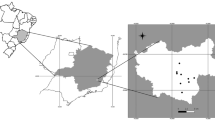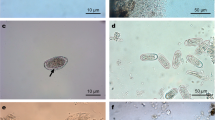Abstract
Parasitological analyses are often based on invasive methodologies, involving host sacrifice, raising ethical and conservation issues. However, alternative non-invasive approaches may not be always applicable due to the location of the parasite in the host tissue or the quality and reliability of the non-invasive sample per se. In this study, we compare the differences in detectability of intestinal parasites in reptiles using the classical invasive approach (intestine dissection), versus a non-invasive procedure (faecal examination), collected from the same individual host. Our results showed significantly lower detectability of helminths in faeces versus the intestine. Moreover, the number of parasites found in faeces was not explained either by the intensities found in the respective intestine or by the host identity. Several factors may explain the lack of association between the two types of samples, but more importantly, our results highlight the randomness of the presence of parasites in faeces. Even if it is not recommended that comparative studies of either parasite abundance or parasite communities be conducted on the basis of faecal samples, there are other types of studies (i.e. genetic) that can be performed with this source of information, thus avoiding the sacrifice of the host. Due to their wide spectrum of life stages and localization in the host tissue, parasites are challenging candidates for non-invasive sampling and consequently, parasitological methodologies should be carefully selected according to the objective of the study.


Similar content being viewed by others
References
Acosta L, León-Quinto T, Bornay-Llinaresa FJ, Simón MA, Esteban JG (2011) Helminth parasites in faecal samples from the endangered Iberian lynx (Lynx pardinus). Vet Parasitol 179:175–179
Adamson ML (1990) Haplodiploidy in the Oxyurida: decoupling the evolutionary processes of adaptation and speciation. Ann Parasitol Hum Comp 65(Suppl 1):31–35
Ashford RW, Lawson H, Butynski TM, Reid GDF (1996) Patterns of intestinal parasitism in the mountain gorilla Gorilla gorilla in the Bwindi-Impenetrable Forest, Uganda. J Zool 239:504–517
Bursey CR, Goldberg SR (2012) A new species of Spauligodon (Nematoda: Oxyuroidea: Pharyngodonidae) in Gonatodes antillensis (Squamata: Sphaerodactylidae) from Bonaire, Lesser Antilles. J Parasitol 98:344–346
Busby GBJ, Gottelli D, Wacher T, Marker L, Belbachir F, Smet K, Belbachir-Bazi A, Fellous A, Belghoul M, Durant SM (2009) Genetic analysis of scat reveals leopard Panthera pardus and cheetah Acinonyx jubatus in southern Algeria. Oryx 43(3):412–415
Carretero MA (2004) From set menu to a la carte. Linking issues in trophic ecology of Mediterranean lacertids. Ital J Zool 74(2):121–133
Carretero MA, Llorente GA (2001) What are they really eating? Stomach versus intestine as sources of diet information in lacertids. In: Vicente L, Crespo EG (eds) Mediterranean Basin Lacertid Lizards: a Biological Approach. ICN, Lisboa, pp 105–112
Carretero MA, Perera A, Harris DJ, Batista V, Pinho C (2006) Spring diet and resource partitioning in an alpine lizard community from Morocco. Afr Zool 41(1):113–122
Couch L, Stone PA, Duszynski DW, Snell HL, Snell HM (1996) A survey of the coccidian parasites of reptiles from islands of the Galápagos archipelago: 1990–1994. J Parasitol 82(3):432–437
Daszak P, Ball SJ, Streicker DG, Jones CG, Snow KR (2011) A new species of Caryospora Leger, 1904 (Apicomplexa: Eimeriidae) from the endangered Round Island boa Casarea dussumieri (Schlegel) (Serpentes: Bolyeridae) of Round Island, Mauritius: an endangered parasite? Syst Parasitol 78:117–122
Diaz JI, Fusaro B, Longarzo L, Coria NR, Vidal V, Jerez S, Ortiz J, Barbosa A (2013) Gastrointestinal helminths of Gentoo penguins (Pygoscelis papua) from Stranger Point, 25 de Mayo/King George Island, Antarctica. Parasitol Res 112:1877–1881
Fenner AL, Smales LR, Bull CM (2011) Using social networks to deduce whether residents or dispersers spread parasites in a lizard population. J Anim Ecol 80(4):835–843
Gyawali P, Khanal S, Shrestha B (2013) Intestinal helminth fauna in sleepy lizard (Tiliqua rugosa) in Australia. Inter J Vet Sci 2(1):17–20
Harrell JrFE, with contributions from Dupont C and many others (2013) Hmisc: Harrell Miscellaneous. R package version 3.10-1.1. http://CRAN.R-project.org/package=Hmisc
Hartigan A, Phalen DN, Šlapeta J (2010) Museum material reveals a frog parasite emergence after the invasion of the cane toad in Australia. Parasit Vectors 3:50
Jorge F, Roca V, Perera A, Harris DJ, Carretero MA (2011) A phylogenetic assessment of the colonisation patterns in Spauligodon atlanticus Astasio-Arbiza et al., 1987 (Nematoda: Oxyurida: Pharyngodonidae), a parasite of lizards of the genus Gallotia Boulenger: no simple answers. Syst Parasitol 80:53–66
Jorge F, Carretero MA, Perera A, Harris DJ, Roca V (2012) A new species of Spauligodon (Nematoda: Oxyurida: Pharyngodonidae) in geckos from São Nicolau island (Cape Verde) and its phylogenetic assessment. J Parasitol 98(1):160–166
Kaliontzopoulou A, Pinho C, Harris DJ, Carretero MA (2011) When cryptic diversity blurs the picture: a cautionary tale from Iberian and North African Podarcis wall lizards. Biol J Linn Soc 103:779–800
Lawrence MA (2012) ez: Easy analysis and visualization of factorial experiments. R package version 4.1-1. http://CRAN.R-project.org/package=ez
Martin JE, Roca V (2005) Helminths of the Atlantic lizard, Gallotia atlantica (Reptilia: Lacertidae), in the Canary Islands (Eastern Atlantic): composition and structure of component communities. Acta Parasitol 50(1):85–89
Martin JE, Roca V, Carretero MA, Llorente GA, Montori A, Santos X (2005) Relationships between diet and helminths in Gallotia caesaris (Sauria: Lacertidae). Zoology 118:121–130
Meijer T, Mattsson R, Angerbjörn A, Osterman-Lind E, Fernández-Aguilar X, Gavier-Widén D (2011) Endoparasites in the endangered Fennoscandian population of arctic foxes (Vulpes lagopus). Eur J Wildl Res 57:923–927
Millán J, Gortazar C, Ballesteros F (2008) Parasites of the endangered Cantabrian capercaillie (Tetrao urogallus cantabricus): correlates with host abundance host family and lek site characteristics. Parasitol Res 103:709–712
Poulin R (1999) The functional importance of parasites in animal communities: many roles at many levels? Int J Parasitol 29(6):903–914
Poulin R (2007) Evolutionary ecology of parasites. Princeton University Press, Princeton
Preston D, Johnson P (2012) Ecological consequences of parasitism. Nat Educ Knowl 3(10):47
R Development Core Team (2011) R: A language and environment for statistical computing. R Foundation for Statistical Computing, Vienna, Austria. ISBN 3-900051-07-0. http://www.R-project.org/
Richter B, Nedorost N, Maderner A, Weissenböck H (2011) Detection of Cryptosporidium species in feces or gastric contents from snakes and lizards as determined by polymerase chain reaction analysis and partial sequencing of the 18S ribosomal RNA gene. J Vet Diagn Invest 23:430–435
Roca V (1999) Relación entre las faunas endoparásitas de reptiles y su tipo de alimentación. Rev Esp Herpetol 13:101–121
Stevens CE, Hume ID (1995) Comparative physiology of the vertebrate digestive system. Cambridge University Press, Cambridge
Torre I, Arrizabalaga A, Freixas L, Ribas A, Flaquer C, Díaz M (2013) Using scats of a generalist carnivore as a tool to monitor small mammal communities in Mediterranean habitats. Basic Appl Ecol 14:155–164
Wimmer B, Craig BH, Pilkington JG, Pemberton JM (2004) Non- invasive assessment of parasitic nematode species diversity in wild Soay sheep using molecular markers. Int J Parasitol 34:625–631
Zhang L, Yang X, Wu H, Gu X, Hu Y, Wei F (2011) The parasites of giant pandas: individual-based measurement in wild animals. J Wildl Dis 47:164–171
Acknowledgments
FJ was funded through a doctoral grant (SFRH/BD/77332/2011) and AP with an Investigador FCT contract (IF/01257/2012). This research is part of the Project “Genomics and Evolutionary Biology” cofinanced by North Portugal Regional Operational Programme 2007/2013 (ON.2–O Novo Norte), under the National Strategic Reference Framework (NSRF), through the European Regional Development Fund (ERDF). We thank Cabildos Insulares (Island Authorities) from Lanzarote, Fuerteventura, Gran Canaria, Tenerife, La Palma, La Gomera and El Hierro from Spain; Servicio de Protección y Conservación de la Naturaleza, Dirección General del Medio Natural, Consejería de Desarrollo Sostenible y Ordenación del Territorio de la Región de Murcia and Junta de Andalucía from Spain; the ICNB from Portugal and Haut Commissariat Eaux et forêts et à la lutte contre la Desertification from Morocco for research permits. Special thanks to A. Kaliontzopoulou and P. Tarroso for the helpful comments.
Author information
Authors and Affiliations
Corresponding author
Rights and permissions
About this article
Cite this article
Jorge, F., Carretero, M.A., Roca, V. et al. What you get is what they have? Detectability of intestinal parasites in reptiles using faeces. Parasitol Res 112, 4001–4007 (2013). https://doi.org/10.1007/s00436-013-3588-8
Received:
Accepted:
Published:
Issue Date:
DOI: https://doi.org/10.1007/s00436-013-3588-8




